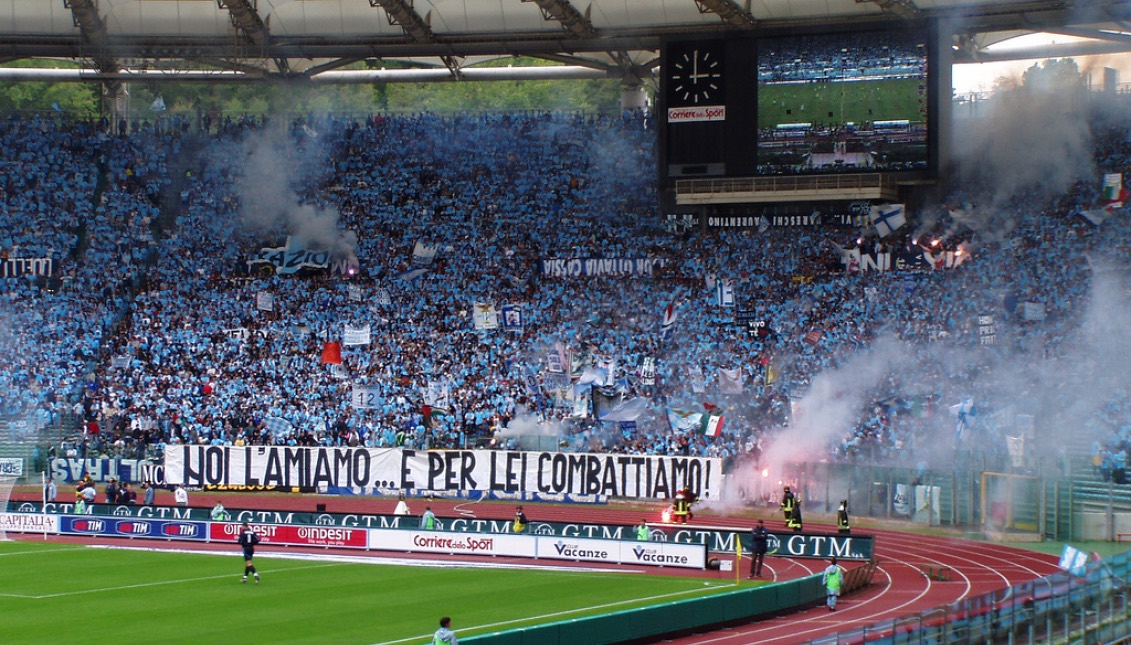
Lazio: Those who forget history are condemned to wear it
MORE IN THIS SECTION
Italian soccer club S.S. Lazio has a brand new kit and an age-old image problem. The club, which plays in Italy’s top flight soccer league, Serie A, did well enough last year to qualify to a European-wide tournament this year. To celebrate the achievement, and take advantage of the higher visibility that comes with it, the club unveiled some very stylish new uniforms. One of these, a black-on-black variant of their traditional light blue shirt, has raised hackles in France. An article in the French newspaper Le Monde immediately linked the black shirts to Lazio’s recent history of neofascist and right-wing fans. Le Monde provocatively referred to the shirts as Lazio’s Third Reich kit.
The club, of course, denies everything. They claim that black is a fashionable color, and that the shirts were approved by European football authorities. Lazio fans, tired of their Fascist label, have pointed out that France’s most popular team, the Parisian giant, PSG, has played all in black in the past, without raising any eyebrows.
But S.S. Lazio is not just any club, and the associations with fascism, both recent and not-so-recent, are multiple and complex. In the past couple of decades, the club has earned a reputation for racist fan behavior in the stands, and for pro-fascist outbursts by at least one player on the field.
The rise of hardcore fan groups linked to neo-fascist politics in the 1990s, gave rise to such infamous displays as the banner aimed at rival A.S. Roma fans reading: “Auschwitz is your town. Ovens are your houses.” Fan signage often displayed white-supremacist Celtic crosses or fans uttered monkey sounds whenever Black players touched the ball.
On the field, in 2005, homegrown Lazio player Paolo Di Canio, who grew up as a hardcore Lazio fan, celebrated a goal against hated rivals Roma with a Roman and fascist salute, which earned the player a suspension and the club a fine. But the punishment meted out by the Italian football association was nowhere near as harsh as the action the Greek association took in a similar, more recent situation.
The most serious recent spasm of racist violence by Lazio supporters was in 2012, when the English Premier League club Tottenham Hotspur visited Rome for an Europa League match against Lazio. Dozens of men, wearing motorcycle helmets, wielding clubs and knives, attacked a handful of Tottenham fans who were drinking in a pub called the Drunken Ship in the center of Rome. Three of the Tottenham fans were seriously injured and hospitalized. Their crime? Tottenham plays in what was once a heavily Jewish neighborhood of London.
Racism and anti-semitism are certainly not unique to Lazio within Italian soccer. Even in the case of the Drunken Ship attack, A.S. Roma fans were also implicated and arrested. Black players in Italy are subjected to racial abuse at all levels of the game, from the youth leagues through the professional ranks.
The Italian football hierarchy seems either insensitive to racism, or to not understand its import. A few months before being elected to head the Italian Football Federation, Carlo Tavecchio complained about African players in Serie A. “Here we get Opti Poba, who previously ate bananas and then suddenly becomes a first-team player ... In England, he must demonstrate his curriculum and his pedigree,” Tavecchio said, using a made up player name to illustrate his point. Despite a European backlash, he went on to be elected to lead Italian football. Tavecchio’s biggest supporter, his right-hand man, is Claudio Lotito, the current owner/President of S.S. Lazio.

In the deeper past lurks Lazio’s most infamous fan, Benito Mussolini, who showed up occasionally at the stadium and was at his ease with the Lazio’s fan following among state workers and displaced rural labor — fascism’s popular base. Mussolini was a great believer in the power of soccer to forge a national identity and pride. Disliking infra-city rivalries which, in his view, fostered internal division, Mussolini reorganized Italian professional soccer to fuse teams in major cities, thus creating one standard-bearer per city. In Rome, three small clubs were joined to create A.S. Roma. The same happened in Florence, to create Fiorentina, and in Naples, to birth Napoli. But Mussolini granted an exemption for Lazio.
Mussolini’s main focus, of course, was the Italian national squad. World Champions in 1934, the Italians set out to defend their crown in 1938, in France, on the threshold of world war. French crowds, swollen with Italian anti-Fascist exiles, booed the Azzurri from the opening game. The Italian players responded by giving the Roman, or Fascist, salute. In the quarter-finals, Italy faced France, the host country, and a hostile crowd. Mussolini sent a new kit for his soccer warriors, an all-black kit, which drove the crowd into a frenzy. Italy won, eventually meeting Hungary in the final. Mussolini sent a telegram to the team: Win or Die, the Fascist motto. They won, 4-2, setting up the Hungarian national side’s goalkeeper, Antal Szabó, with one of soccer's all-time best one-liners (though likely apocryphal): “I let in goals, but I saved lives.”






LEAVE A COMMENT:
Join the discussion! Leave a comment.